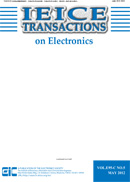E102.C 巻, 4 号
選択された号の論文の18件中1~18を表示しています
- |<
- <
- 1
- >
- >|
Special Section on Solid-State Circuit Design — Architecture, Circuit, Device and Design Methodology
-
2019 年E102.C 巻4 号 p. 243-244
発行日: 2019/04/01
公開日: 2019/04/01
PDF形式でダウンロード (73K) -
原稿種別: INVITED PAPER
2019 年E102.C 巻4 号 p. 245-259
発行日: 2019/04/01
公開日: 2019/04/01
PDF形式でダウンロード (2372K) -
原稿種別: PAPER
2019 年E102.C 巻4 号 p. 260-268
発行日: 2019/04/01
公開日: 2019/04/01
PDF形式でダウンロード (1200K) -
原稿種別: PAPER
2019 年E102.C 巻4 号 p. 269-275
発行日: 2019/04/01
公開日: 2019/04/01
PDF形式でダウンロード (1280K) -
原稿種別: PAPER
2019 年E102.C 巻4 号 p. 276-286
発行日: 2019/04/01
公開日: 2019/04/01
PDF形式でダウンロード (4622K) -
原稿種別: PAPER
2019 年E102.C 巻4 号 p. 287-295
発行日: 2019/04/01
公開日: 2019/04/01
PDF形式でダウンロード (2059K) -
原稿種別: PAPER
2019 年E102.C 巻4 号 p. 296-302
発行日: 2019/04/01
公開日: 2019/04/01
PDF形式でダウンロード (861K)
Special Section on Progress in Optical Device Technology for Increasing Data Transmission Capacity
-
2019 年E102.C 巻4 号 p. 303
発行日: 2019/04/01
公開日: 2019/04/01
PDF形式でダウンロード (75K) -
原稿種別: INVITED PAPER
2019 年E102.C 巻4 号 p. 304-315
発行日: 2019/04/01
公開日: 2019/04/01
PDF形式でダウンロード (3510K) -
原稿種別: INVITED PAPER
2019 年E102.C 巻4 号 p. 316-323
発行日: 2019/04/01
公開日: 2019/04/01
PDF形式でダウンロード (1207K) -
原稿種別: INVITED PAPER
2019 年E102.C 巻4 号 p. 324-332
発行日: 2019/04/01
公開日: 2019/04/01
PDF形式でダウンロード (4001K) -
原稿種別: INVITED PAPER
2019 年E102.C 巻4 号 p. 333-339
発行日: 2019/04/01
公開日: 2019/04/01
PDF形式でダウンロード (2178K) -
原稿種別: INVITED PAPER
2019 年E102.C 巻4 号 p. 340-346
発行日: 2019/04/01
公開日: 2019/04/01
PDF形式でダウンロード (2041K) -
原稿種別: INVITED PAPER
2019 年E102.C 巻4 号 p. 347-356
発行日: 2019/04/01
公開日: 2019/04/01
PDF形式でダウンロード (2067K) -
原稿種別: INVITED PAPER
2019 年E102.C 巻4 号 p. 357-363
発行日: 2019/04/01
公開日: 2019/04/01
PDF形式でダウンロード (1715K) -
原稿種別: INVITED PAPER
2019 年E102.C 巻4 号 p. 364-370
発行日: 2019/04/01
公開日: 2019/04/01
PDF形式でダウンロード (1157K)
Regular Section
-
原稿種別: PAPER
専門分野: Electromagnetic Theory
2019 年E102.C 巻4 号 p. 371-379
発行日: 2019/04/01
公開日: 2019/04/01
PDF形式でダウンロード (2563K) -
原稿種別: PAPER
専門分野: Optoelectronics
2019 年E102.C 巻4 号 p. 380-387
発行日: 2019/04/01
公開日: 2019/04/01
PDF形式でダウンロード (895K)
- |<
- <
- 1
- >
- >|
